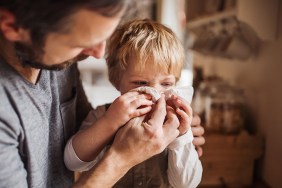Croup
The symptoms: Children between ages 3 months and 5 years are more likely to develop croup than older kids. It typically occurs in the fall and winter, and it can be characterized by a seal-like barking cough. Although it can be mild, croup isn’t harmless, and as the child’s upper airway increasingly swells, breathing can become difficult for a child with croup, particularly at night. As the croup worsens and the airway narrows, a noisy, high-pitched breathing called stridor can develop, as can retractions, which is when the child is breathing so hard that the skin around the ribs and sternum pulls inward.
What causes it: A group of viruses known as parainfluenza viruses that are spread through coughing and sneezing are typically the main culprit, though other types of infections and conditions can sometimes lead to it as well.
What to do: Contact your child’s doctor. According to the AAP, if your child’s croup is mild, your doctor might recommend that you try sitting in steamy bathroom (not in the shower) with your child to see if that moist air provides relief. Running a humidifier or a cold-water vaporizer in your kid’s room can also be beneficial. Cool, night air may help relieve mild croup. But if your child’s croup gets worse, he has trouble swallowing or is drooling, experiences stridor when he’s sitting or is resting, or if the skin around his ribs is retracting, seek immediate medical help. The AAP recommends taking your child straight to the emergency room if your child is struggling to breathe or can’t speak because of it, or if your child gets very sleepy or turns blue when she coughs.








